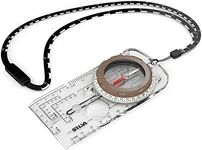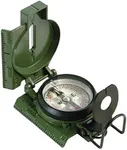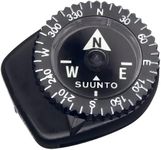Buying Guide for the Best Hiking Compasses
Choosing the right hiking compass is essential for ensuring you can navigate effectively and safely during your outdoor adventures. A good compass will help you determine your direction, plan your route, and stay on track. When selecting a hiking compass, it's important to understand the key specifications and how they relate to your needs. Here are some important factors to consider when picking the best compass for your hiking trips.Type of CompassThere are several types of compasses, including baseplate compasses, lensatic compasses, and digital compasses. Baseplate compasses are popular for hiking because they are easy to use and can be placed directly on a map for navigation. Lensatic compasses are more rugged and often used by the military, while digital compasses offer advanced features like GPS integration. Choose a type based on your familiarity with compass use and the level of precision you need.
Needle StabilityNeedle stability refers to how quickly the needle settles and points to magnetic north. A stable needle is crucial for accurate navigation, especially in challenging conditions. Compasses with liquid-filled capsules tend to have more stable needles, as the liquid helps dampen movement. If you plan to hike in areas with rough terrain or frequent changes in direction, opt for a compass with good needle stability.
Declination AdjustmentDeclination adjustment allows you to account for the difference between magnetic north and true north. This feature is important for accurate navigation, especially in areas with significant declination. Some compasses have a fixed declination adjustment, while others allow you to set it manually. If you hike in regions with varying declination, a compass with adjustable declination will be more useful.
Sighting MirrorA sighting mirror helps you take precise bearings by allowing you to see the compass dial and your target simultaneously. This feature is particularly useful for long-distance navigation and when you need to pinpoint specific landmarks. If your hikes involve navigating through dense forests or across vast landscapes, a compass with a sighting mirror can enhance your accuracy.
Luminescent MarkingsLuminescent markings on a compass make it easier to read in low-light conditions, such as early morning or late evening hikes. These markings glow in the dark, allowing you to navigate without needing an external light source. If you often hike during times when visibility is low, consider a compass with luminescent markings to ensure you can read it clearly at all times.
DurabilityDurability is important for any hiking gear, and compasses are no exception. Look for compasses made from robust materials that can withstand drops, impacts, and harsh weather conditions. A durable compass will last longer and perform reliably in tough environments. If you frequently hike in rugged terrain or extreme weather, prioritize a compass with high durability.
Size and WeightThe size and weight of a compass can affect its portability and ease of use. Smaller, lightweight compasses are easier to carry and handle, but they may have fewer features. Larger compasses often offer more advanced features but can be bulkier. Consider how much space you have in your gear and how comfortable you are with handling different sizes when choosing a compass.















